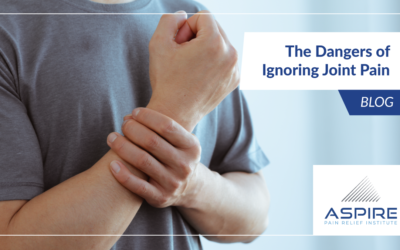Learning Center
Make An Appointment
Learning Center
Make An Appointment
Blog Articles by Aspire Pain Relief Institute
Precision in Practice: Ultrasound-Guided Disc Procedures for Back Pain Relief in Tampa
In the United States, back pain remains a prevalent and serious issue affecting many individuals. Conditions like scoliosis and spinal fractures can lead to discomfort, frustration, and even hinder daily activities. Traditionally, treatments for back pain often...
Improve Your Health in 2022 with These Health Tips
Your Life Improves When Your Health Does It's a brand new year, so happy 2022! It's also the perfect time to start adopting some healthy habits that will keep you at the "top of your game" for the next 12 months and beyond. Maintaining your health and wellness is more...
Is It Normal to Experience Pain Every Day?
Everyone suffers minor aches and pains occasionally. However, it is not normal to suffer daily pain. Fortunately, there are specialists dedicated to getting to the root of your discomfort so that you can truly heal rather than mask the pain. Have you suffered daily...
The Dangers of Ignoring Joint Pain
If you have acute or chronic joint pain, don't put off treatment. Doing so can cause permanent damage and leave you suffering far longer than necessary. Perhaps you hurt your knee in a sports injury or fell on a slippery sidewalk. Whatever caused your condition, our...
What Should I Look for in a Pain Management Clinic?
When you're in pain, your body is trying to tell you that something is wrong. However, without the help of experienced and well-trained medical professionals, figuring out the problem isn't always so easy. At Aspire, our goal is to carefully identify the true source...
Back Pain Away for Good: Innovative Treatments in Tampa
When it comes time to finally seek treatment for your back pain, the options can sometimes be daunting and overwhelming, we get it. Back pain treatments can come in various shapes, sizes, types, frequencies, and forms, so how can you decide which one suits you best?
Video Treatment Library
Neurological Treatments in Tampa
Head Conditions
This chronic condition is caused by a misfiring of the trigeminal nerve. An attack causes brief episodes of extreme, shooting pain.
Spine Surgical Care and Management
This is a procedure to treat a herniated disc. That’s a bulging disc in your spine. Getting rid of the bulge can relieve pressure on your nerves. It can relieve pain in your lower back and your legs.
Arm and Elbow Care and Pain Management
During this minimally-invasive procedure, the physician uses heat from radio waves to treat painful facet joints in your neck. This procedure is also called radiofrequency rhizotomy. It can treat pain that doesn’t respond to medications or to physical therapy.
This injection treats the pain of an inflamed nerve in your cervical spine. It relieves nerve swelling. If you have a herniated disc, spinal stenosis or some other problem that’s pressing on a nerve, it may help you.
Spinal cord stimulation (also called SCS) uses electrical impulses to relieve chronic pain of the back, arms and legs. It is believed that electrical pulses prevent pain signals from being received by the brain.
SCS candidates include people who suffer from neuropathic pain and for whom conservative treatments have failed.
General Body Care and Pain Management
This procedure is an injection that numbs branches of nerves in your lower back. It helps doctors find and treat a number of problems linked to these nerves. Usually, a series of injections is needed to treat a problem.
A stellate ganglion nerve block is an injection that numbs branches of nerves in your neck. This helps doctors find and treat a number of problems linked to the nerves. Treatment may require a series of injections.
This outpatient procedure is designed to reduce or relieve the pain of trigger points. These small, tender knots can form in muscles or in the fascia (the soft, stretchy connective tissue that surrounds muscles and organs). The trigger point injection procedure takes only a few minutes to complete.
Head, Neck and Spine Care and Pain Management
This outpatient procedure is an injection of a steroid-anesthetic medication through an opening in the sacrum. The medication can reduce swelling and inflammation of irritated spinal nerves. The injection takes only a few minutes to complete.
This procedure temporarily disrupts the nerves of the celiac plexus. These nerves branch away from your spine. They connect to the organs in your abdomen. Pain signals caused by conditions such as pancreatitis or pancreatic cancer travel through these nerves on the way to your brain. A celiac plexus block can relieve your pain.
The facet joints, found on both sides of the back of the spine, can become painfully irritated or inflamed. A facet joint injection may help diagnose the source of a patient’s pain. It can also relieve pain and inflammation.
An intrathecal pump relieves chronic pain. It uses small amounts of medicine applied directly to the intrathecal space (the area surrounding the spinal cord) to prevent pain signals from being perceived by the brain. Pump candidates include people for whom conservative treatments have failed and surgery is not likely to help.
This minimally-invasive procedure repairs a vertebral compression fracture. It helps restore the spine’s natural shape. Some patients experience rapid pain relief after the procedure.
This injection procedure is performed to relieve low back and radiating leg pain. Steroid medication can reduce the swelling and inflammation caused by spinal conditions.
This outpatient procedure is an injection of a steroid-anesthetic medication. The medication can reduce swelling and inflammation of irritated spinal nerves. This procedure is performed to relieve pain in the lower back and pain that radiates from the back to the legs. The injection takes only a few minutes to complete.
This is an injection of numbing medicine. It bathes the medial branch nerves, which attach to the facet joints of your spine. These nerves hurt when facet joints are injured or diseased. The injection helps find the source of your pain. And it may relieve your pain for a brief time.
This injection procedure is performed to relieve pain caused by arthritis in the sacroiliac joint where the spine and hip bone meet. The steroid medication can reduce swelling and inflammation in the joint.
Hip, Leg and Knee Care and Pain Management
If you have pain in your hip, your doctor may inject medicine into your hip joint. It can help your doctor find where your pain is coming from. It can also make your hip feel better.
During this minimally-invasive procedure, the physician uses heat from radio waves to treat painful facet joints in your lower back. This procedure is also called radiofrequency rhizotomy. It can treat pain that doesn’t respond to medications or to physical therapy.
This non-operative, outpatient procedure is designed to provide relief for patients with hip and lower abdominal pain. The technique allows the physician to inject an inflammation-reducing steroid around the ilioinguinal nerve with maximum accuracy.
This is an injection of medicine into the knee joint. It lubricates your knee so the bones can glide smoothly. It can help lessen the pain of arthritis.
Shoulder Care and Pain Management
This outpatient injection procedure relieves pain in the shoulder and arm caused by arthritis, injury or disorder.






